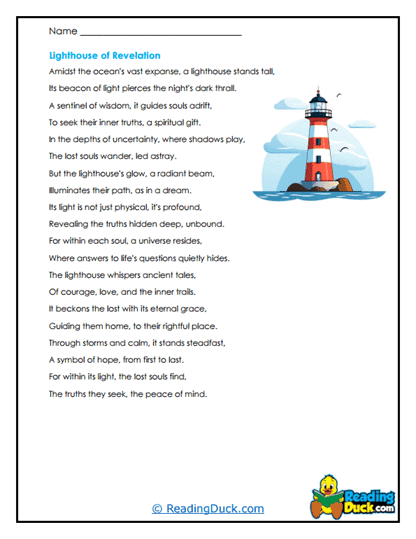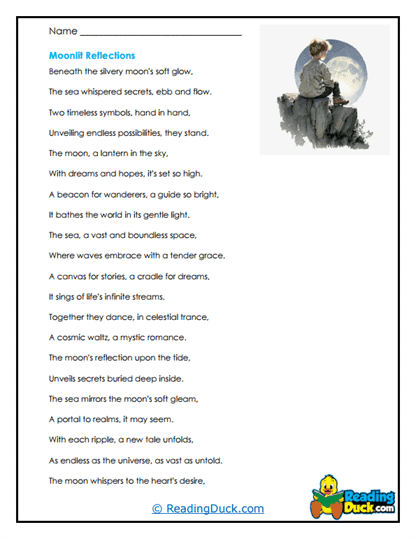Symbolist Poetry Worksheets
About Our Symbolist Poetry Worksheets
Our Symbolist Poetry Worksheets offer a thorough and creative approach to understanding one of the most evocative and abstract genres in poetry. As part of the Reading Poetry category within the Genres section, this collection focuses on symbolist poetry—a genre known for its use of imagery, symbols, and metaphors to express complex emotions and philosophical ideas. Each worksheet set contains a reading passage aligned with the symbolist poetry genre, followed by multiple-choice questions, short answer questions, and open-ended response prompts that guide students through the poem’s meaning and structure.
These worksheets are presented in an easy-to-use PDF format, making them accessible for downloading, printing, and viewing in various learning environments. Each set includes a downloadable answer key, allowing educators to quickly and efficiently assess student comprehension and engagement. Through these worksheets, students will not only gain an appreciation for the nuanced nature of symbolist poetry but also develop crucial analytical and interpretive skills.
The Symbolist Poetry Genre: Themes, Characteristics, and Its Role in Literature
Symbolist poetry, which emerged in the late 19th century, is a genre that seeks to convey emotional depth and abstract ideas through the use of symbols, metaphor, and vivid imagery. Instead of directly stating a poet’s thoughts or emotions, symbolist poets employ suggestive language that evokes deeper meanings, inviting readers to interpret the underlying themes and ideas for themselves. Key figures in the symbolist movement include poets such as Stéphane Mallarmé, Charles Baudelaire, and Arthur Rimbaud, whose works exemplify the genre’s focus on conveying the ineffable—those aspects of life and existence that cannot easily be expressed through ordinary language.
Symbolist poetry often explores themes of mystery, spirituality, dream-like visions, and existential contemplation. These themes are communicated through richly layered symbolism, allowing for multiple interpretations. The emphasis is less on linear narrative and more on evoking a particular mood, feeling, or atmosphere. The symbolic imagery found in these poems may represent concepts such as death, love, time, or the human psyche.
This genre is important for students to study because it encourages them to go beyond literal understanding and engage in deeper, more abstract thinking. By analyzing the ways in which poets use symbols to represent complex ideas, students develop an appreciation for how language can transcend straightforward meaning to explore the hidden layers of human experience.
- Key Themes: Mystery, spirituality, dream-like visions, existential contemplation, emotion, and abstraction.
- Characteristics: Use of symbols, metaphors, rich imagery, suggestive language, and mood over narrative.
- Significance: Symbolist poetry challenges students to engage in deep analysis, exploring the abstract and emotional layers of language and meaning.
The Symbolist Poetry Worksheets allow students to experience the beauty and depth of this genre, while also supporting educators with easy-to-use, printable resources that include downloadable answer keys for efficient assessment.
Building Key Skills Through Symbolist Poetry
Our Symbolist Poetry Worksheets are designed to develop a range of important literary skills, including reading comprehension, critical thinking, and creative expression. The abstract and metaphorical nature of symbolist poetry offers students a unique challenge, requiring them to engage deeply with both the text’s surface meaning and its underlying symbolism.
Each worksheet begins with multiple-choice questions that help students identify key elements of the poem, such as its central theme, use of imagery, and tone. These questions help solidify students’ understanding of the poem’s overall structure and content, serving as a foundation for more in-depth analysis. Short answer questions encourage students to explore specific aspects of the poem, such as how the poet uses particular symbols or metaphors to convey deeper meaning, or how the poem’s mood reflects its underlying themes.
Open-ended response questions prompt students to reflect on the emotional and philosophical dimensions of the poem, encouraging them to consider how the poet’s use of language creates layers of meaning. By analyzing how imagery and symbolism work together, students gain insight into the ways in which symbolist poets create abstract representations of complex ideas and emotions.
Through working with these worksheets, students develop the following skills:
- Reading Comprehension: Students learn to identify and interpret the key symbols, themes, and imagery within the poem.
- Critical Thinking: By analyzing how symbols and metaphors convey deeper meanings, students engage in thoughtful, abstract exploration of the text.
- Creative Expression: Open-ended responses allow students to reflect on their personal interpretations and connect emotionally with the poem’s themes.
The Symbolist Poetry Worksheets help students enhance their ability to interpret and appreciate poetry, all while building the foundational literary skills necessary for more advanced analysis.
Versatile Use Across Different Educational Settings
One of the key strengths of our Symbolist Poetry Worksheets is their adaptability to a variety of educational settings, making them ideal for traditional classrooms, homeschooling, and independent study. The abstract nature of symbolist poetry encourages creative thinking and interpretation, making these worksheets suitable for group activities, individual assignments, or enrichment exercises.
In classroom environments, teachers can use these worksheets to spark group discussions or collaborative analysis of a poem’s themes and symbols. Students can work together to identify the layers of meaning within a poem, exploring how different symbols and metaphors contribute to its overall effect. These group activities promote deeper understanding through discussion and shared interpretations, helping students see how multiple perspectives can enhance the reading of a poem.
For homeschooling, the Symbolist Poetry Worksheets provide a structured yet flexible way to introduce students to this challenging genre. Parents or homeschool educators can guide students through the analysis process, offering support and guidance while encouraging independent thought and interpretation. Homeschool students benefit from the personal engagement and deep analysis that symbolist poetry demands, developing both their analytical skills and creative thinking.
Independent learners will also find these worksheets to be a valuable tool for self-guided exploration of symbolist poetry. The PDF format ensures easy access to the materials, while the downloadable answer keys provide immediate feedback for self-assessment. These worksheets are perfect for students looking to deepen their understanding of poetry through independent study or enrichment assignments.
- Classroom Use: Ideal for group discussions, collaborative analysis, or individual assignments.
- Homeschooling: Provides structured yet adaptable resources for in-depth exploration of symbolism and metaphor.
- Independent Study: Perfect for self-paced learning with immediate feedback through answer keys.
The flexibility of these worksheets ensures that they can be effectively used in a variety of educational contexts, supporting both teachers and students in their exploration of symbolist poetry.
Deepening Interpretation and Analytical Skills
Symbolist poetry is rich with layers of meaning, providing an excellent opportunity for students to sharpen their analytical skills and practice close reading. Our Symbolist Poetry Worksheets are designed to guide students through the process of interpreting symbols, metaphors, and imagery, helping them understand how these elements contribute to the poem’s overall theme and mood.
Through carefully crafted questions, students are encouraged to analyze how symbols in the poem evoke specific emotions or ideas. For example, a worksheet might ask students to examine how a particular image represents an abstract concept such as time, death, or memory. By focusing on how the poet’s language evokes sensory experiences and emotional responses, students learn to appreciate the subtleties of the genre.
Close reading exercises also prompt students to consider how the structure and form of the poem support its symbolic content. They might be asked to explore how the arrangement of lines, the use of repetition, or the poem’s rhythm enhances its dream-like or mystical qualities. These exercises help students develop confidence in their ability to analyze complex literary works, building the skills necessary to interpret poetry at a deeper level.
- Close Reading: Encourages students to examine how symbols, imagery, and structure work together to create meaning.
- Literary Devices: Focuses on metaphor, symbolism, and imagery, helping students interpret the abstract layers of the poem.
- Analytical Confidence: Builds students’ confidence in their ability to analyze and interpret complex texts.
These worksheets provide a comprehensive framework for exploring the depth of symbolist poetry, guiding students to think critically about language and its role in creating meaning.
Encouraging Creative Writing and Symbolism
Our Symbolist Poetry Worksheets not only support analytical learning but also encourage students to explore their own creativity through guided writing exercises. Writing symbolist poetry offers students the chance to experiment with using symbols and metaphors to convey complex emotions or abstract ideas, helping them deepen their understanding of how these devices function in poetry.
Each worksheet set includes creative writing prompts that challenge students to compose their own symbolist poems. For example, students might be asked to write a poem that uses a specific symbol—such as a natural element or an everyday object—to represent a deeper philosophical idea or personal feeling. These prompts encourage students to think carefully about how their language choices evoke mood, atmosphere, and meaning.
By experimenting with symbolism in their own writing, students not only develop their poetic skills but also gain a deeper appreciation for the genre’s complexity. Writing symbolist poetry requires students to consider how form, imagery, and metaphor work together to create an abstract, multi-layered expression of thought or emotion.
- Writing Prompts: Creative exercises encourage students to use symbols and metaphors in their own poetry.
- Creative Exploration: Helps students explore abstract ideas and emotions through poetic language.
- Developing Technique: Writing exercises reinforce the use of literary devices and structure in creating meaning.
These writing activities give students an exciting opportunity to apply what they’ve learned, fostering both creative expression and a deeper understanding of symbolist poetry.
Conclusion: A Complete Resource for Studying Symbolist Poetry
Our Symbolist Poetry Worksheets offer a comprehensive and engaging resource for exploring one of poetry’s most abstract and thought-provoking genres. By combining reading comprehension, critical analysis, and creative writing, these worksheets give students the tools they need to interpret and appreciate the rich symbolism and imagery of symbolist poetry.
Whether used in traditional classrooms, homeschooling, or for independent study, these worksheets provide a flexible and adaptable way to engage with symbolist poetry. Through close reading exercises, thoughtful analysis, and creative writing prompts, students gain a deeper understanding of how symbolist poets use language to express the ineffable, exploring the intersection of emotion, philosophy, and abstraction. With our Symbolist Poetry Worksheets, students not only learn to analyze and interpret this challenging genre but also have the opportunity to create their own poems, discovering the power of symbolism in their own writing.









